This Cuban roast pork (lechon asado) is marinated in a homemade mojo marinade overnight and then roasted low and slow until it’s fall apart tender.
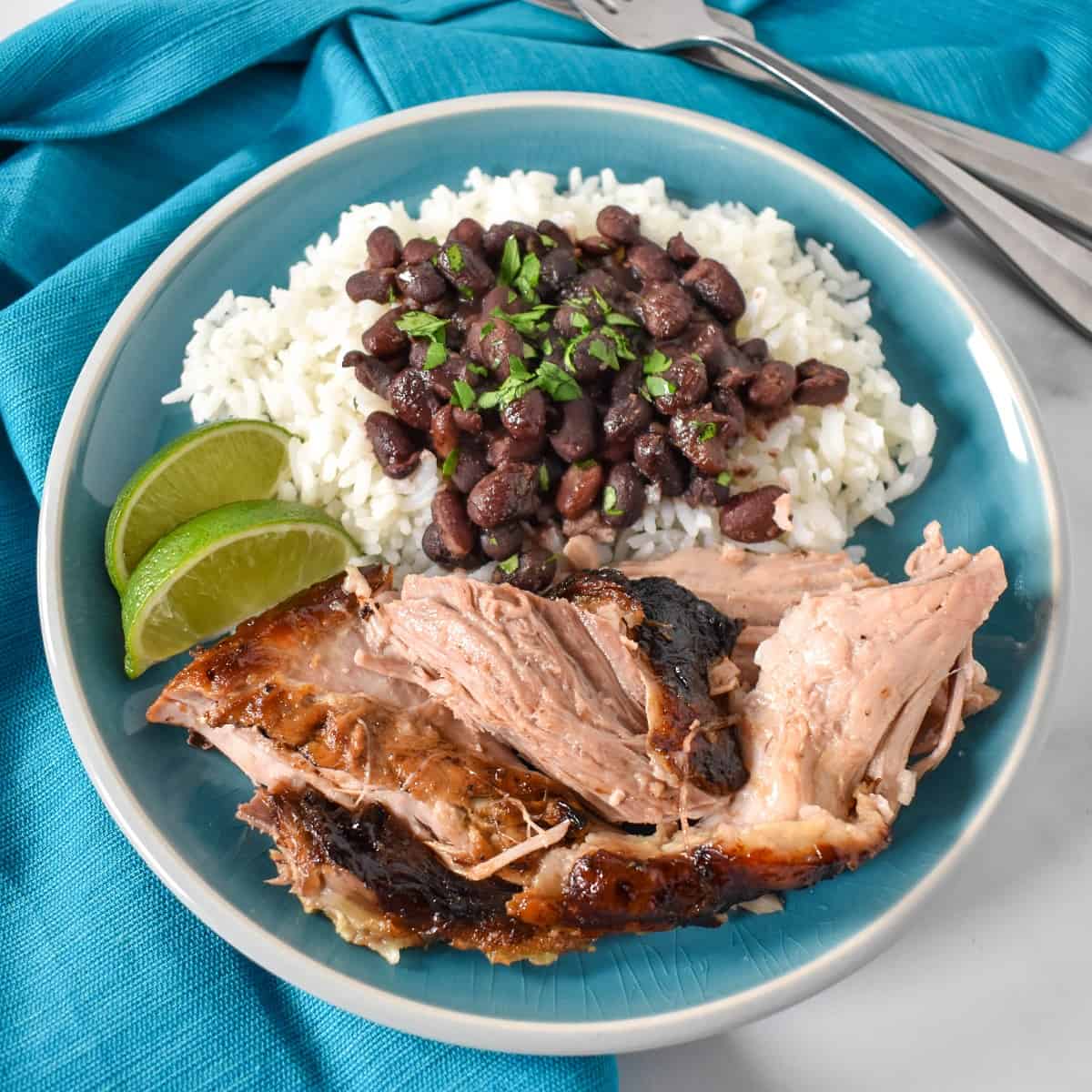
In Cuban Culture, roast pork, or lechon asado, is the meal served on all special occasions. Christmas, Weddings, New Year’s, you name it… roast pork is on the menu. This is a traditional recipe using a homemade mojo marinade.
This lechon recipe is for a large roast (8-10 pounds). We recommend keeping to roughly that size for these recipe instructions. I know it’s a lot of meat but trust me, it goes quickly.
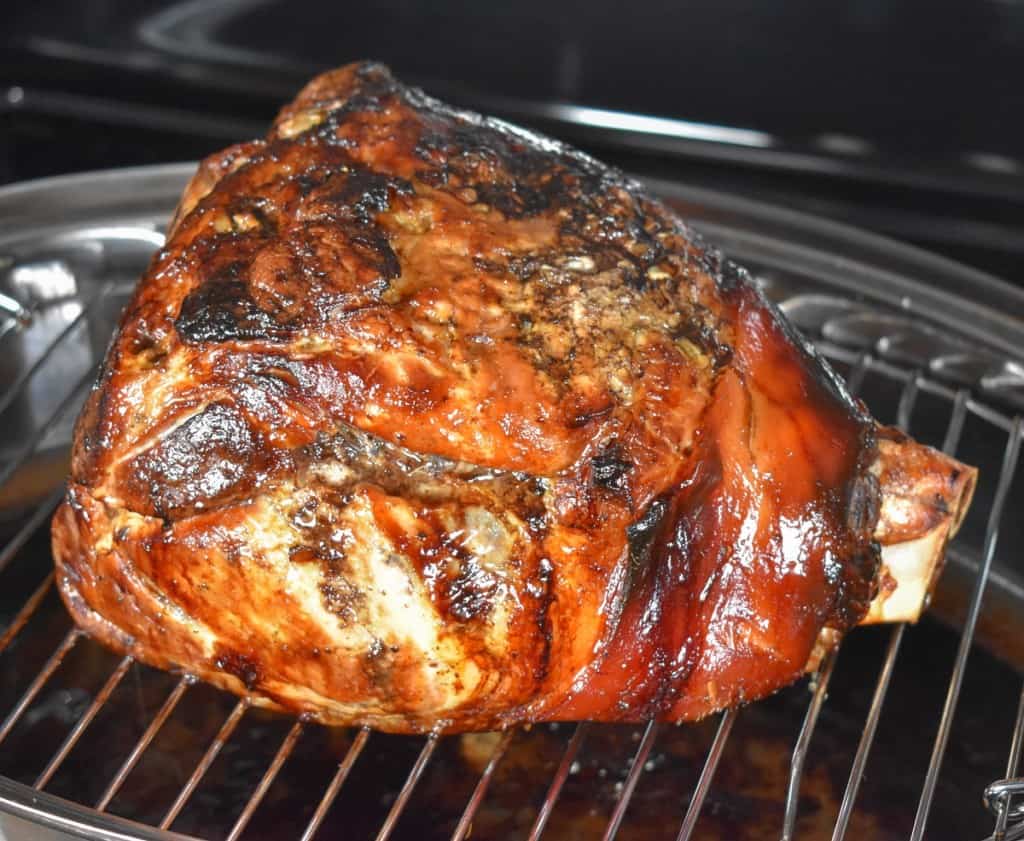
Use the leftovers to make the famous Cuban sandwich (aka a Cubano). You can also make a midnight sandwich, which is like the Cubano but with a sweet bread that is similar to brioche. For the ultimate pork sandwich make a pan con lechon, which is Cuban bread loaded with the pork and thinly sliced onions.
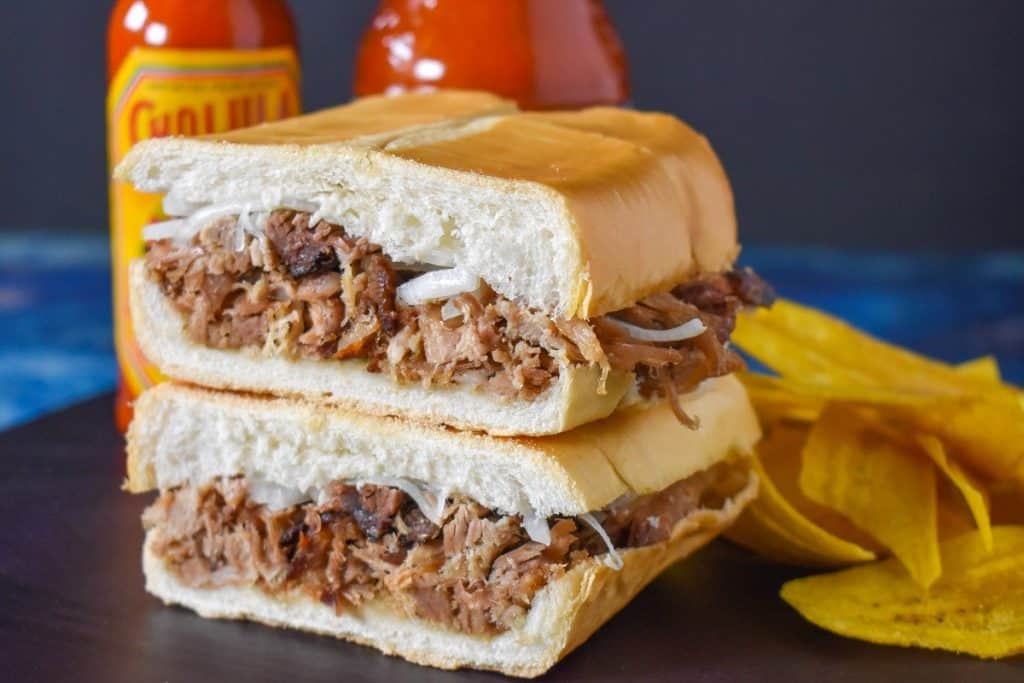
Cuban roast pork is a two-day event. The pork needs to marinate in the refrigerator overnight. Then you roast it, low and slow for hours, so make sure you plan for that.
Something else to plan for, have plenty of snacks on roasting day because while the pork is cooking your house will smell amazing. Everyone will be asking: “when will it be ready?” “Is it ready yet?” Enjoy!
This site contains affiliate links to products. As an Amazon Associate I earn from qualifying purchases.
Best cut of meat for roast pork
Lechon is Spanish for pork. For Cubans, lechon (or lechon asado) refers to roasted pork that’s marinated in mojo (a garlicky-citrus sauce). Lechon can be a whole pig or a piece of the pig that’s cooked in a pit, a Caja China (an outdoor roasting box that uses coals to cook), a traditional barbeque or an oven.
Since a whole pig won’t fit in an oven or a regular barbecue, a piece of pork is cooked instead. This is also called lechon asado. For me, the best cut of meat for roasting is the pork shoulder, also called pork picnic.
The shoulder comes from the front leg of a pig as opposed to the hind legs which are called hams. Pork shoulder is a fatty and flavorful cut of meat that works well with a long cooking time. That said, the fresh ham can also be (and is) used to make roast pork. In Spanish the pork shoulder is called paleta asada and the ham is called pierna asada.
What is mojo
Mojo is a citrus and garlic sauce that is used for pork, chicken and other meat or vegetable dishes. The citrus juice used is traditionally sour oranges (naranja agria in Spanish). Finding sour oranges can be a challenge depending on where you live. During the latter part of the year many Latin markets will stock sour oranges.
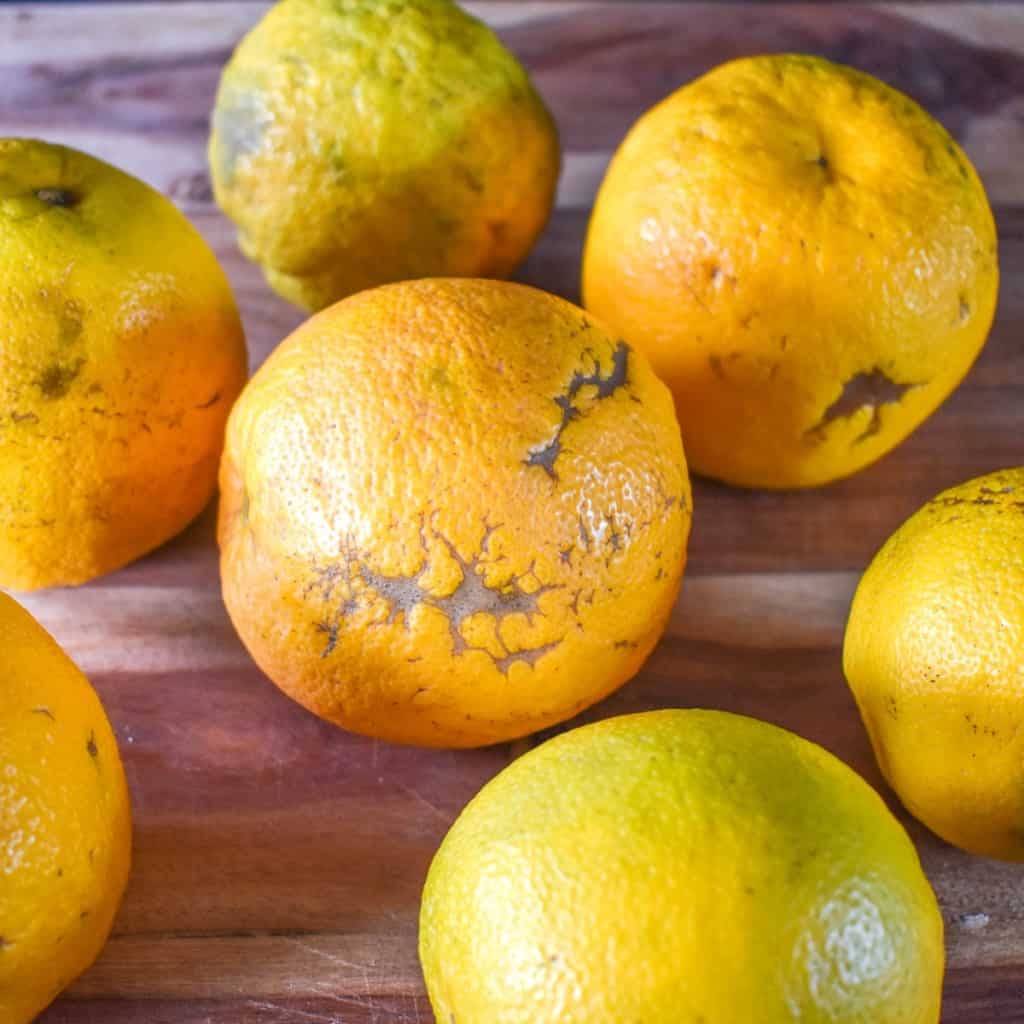
If you can’t find sour oranges, you can make a good substitute by combining orange juice (fresh squeezed is best) and lime juice at a 2:1 ratio. Two parts orange juice to one part lime juice. So, for this recipe it would be 1 cup of orange juice and ½ cup lime juice. Shake or stir well to combine.
Another alternative to consider is bottled sour orange juice. Even if it’s not the real thing, it will still get you that slightly sweet and sour taste you’re looking for. Find it in the international section of larger grocery stores and online. To learn more about sour oranges and mojo check out our mojo marinade recipe.
Ingredients
- Pork shoulder – Choose a large pork shoulder (also called pork picnic) we recommend 8-10 pounds. As a reference ours is 9¼ pounds. You can make a smaller roast, but you will have to adjust the roasting time.
- Garlic – We’ll need two heads, one for the mojo and one for the pork.
- Sour orange juice – If you cannot find sour oranges, use fresh squeezed orange and lime juice at a 2:1 ratio, or use bottled sour orange juice (naranja agria).
- Olive Oil – We used extra virgin olive oil.
- Spices – Dried oregano, cumin, bay leaf and salt (we use kosher salt).
You will also need:
- Mortar and pestle to breakdown the garlic
- Jar or container with a tight-fitting lid to keep the mojo
- Meat mallet to smash the garlic (or use the side of a large knife)
- Large pan to marinate to pork
- Large marinating or roasting bag or Plastic wrap to cover the pork while marinating
- Large roasting pan with a rack
- Aluminum Foil
- Cooking Spray
Make the mojo marinade
Peel the 2 heads of garlic. Reserve 8-10 whole garlic cloves for the pork.
Smash the remaining garlic cloves; place them on a cutting board and give them a good whack with a meat mallet or the side of a large knife.
Add the peeled, smashed garlic and 1 teaspoon salt to a mortar and pestle. Work the garlic until you break it down into small flat pieces.
Add the smashed garlic, sour orange juice, olive oil, oregano, cumin, 1½ teaspoon salt, and the bay leaf to a medium bowl or jar. Stir or shake to combine well. Cover the jar/bowl and let the marinade sit in the refrigerator for at least 1 hour, a couple of hours or overnight is better. Shake or stir well before using.
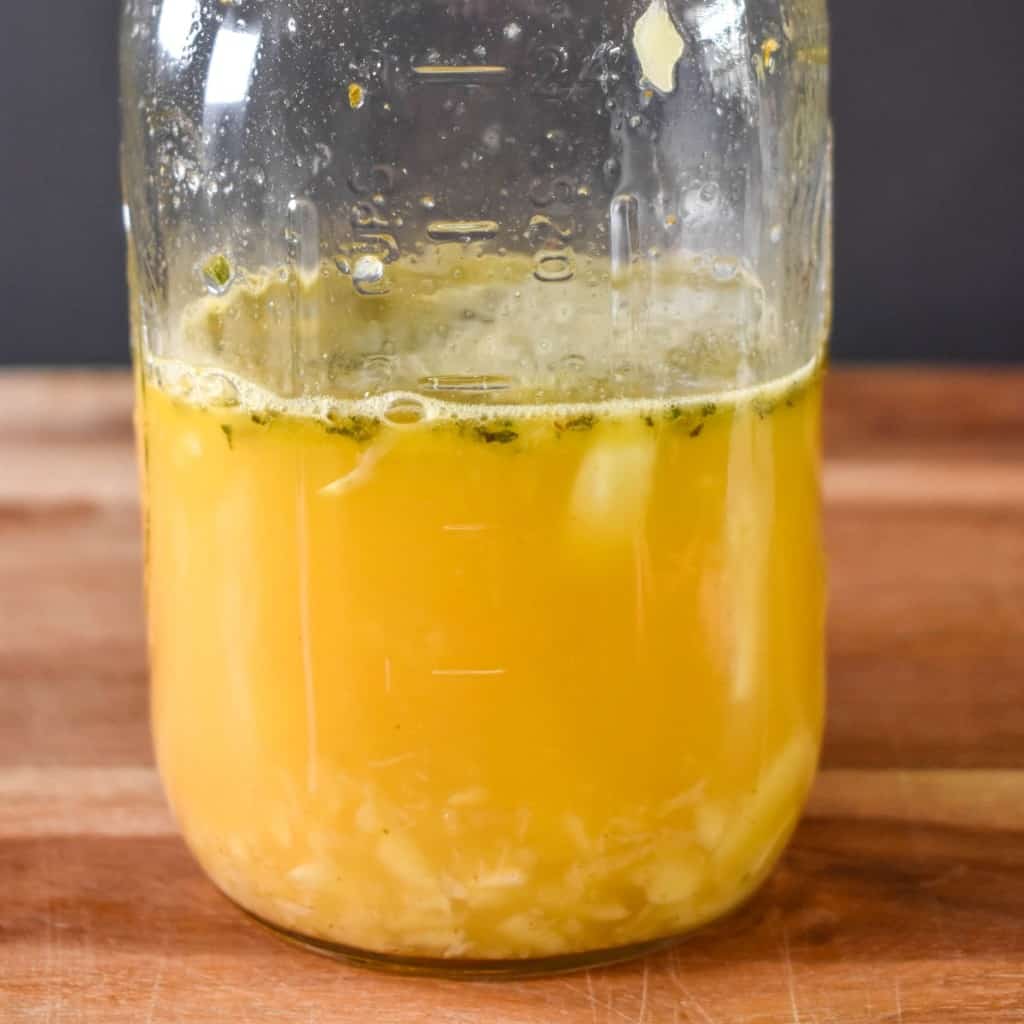
Marinate the pork
We lined the pan with a large oven bag. We found them in the foil and plastic wrap section of the supermarket (they’re made for turkeys). These bags are great because they contain the mojo and you can seal them tight with a knot.
- Place the pork in a large pan, make 8-10 small slits (about 1-2 inch deep) on the skin side and insert the reserved (whole) garlic cloves into the slits. Tip: Dip the clove in the marinade for easy insertion.
- Turn the pork over (skin side down) and make about 10-12 small slits (about 1-2 inch deep) in the meat. Use a ladle or spoon to pour the marinade into the slits you made.
- Then pour the remaining marinade over the pork. Sprinkle 1 teaspoon of salt over the pork, if desired.
- Turn the pork again so that the skin side is up, and the fleshy side is sitting in the marinade. Seal the bag by making a tight knot on the top, or cover the pan well using a generous amount of plastic wrap. Seriously, use several layers. The smell of this marinating pork is strong and will permeate the refrigerator. While the pork roast marinade is delicious, I don’t want my refrigerator smelling like it for days.
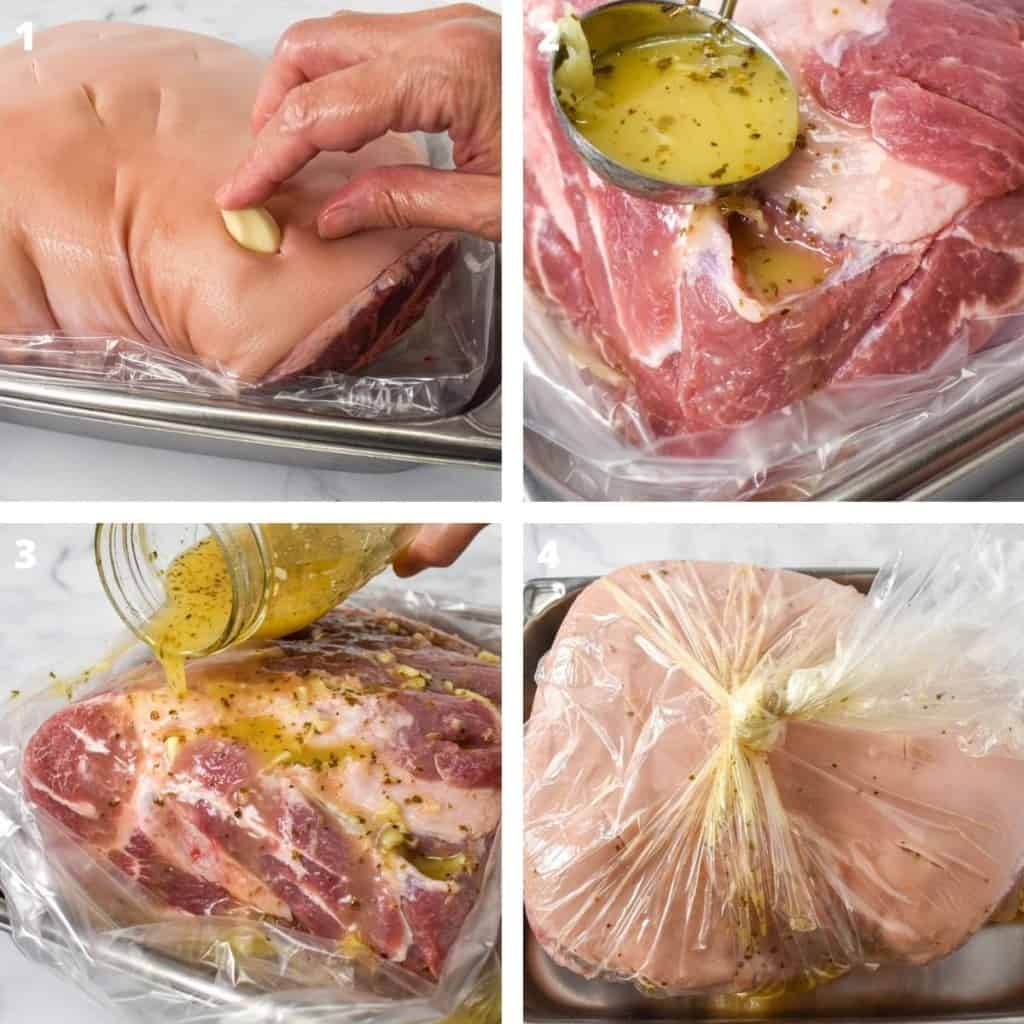
Marinate the Cuban roast pork in the refrigerator overnight.
Roasting instructions
Remove the pork shoulder from the refrigerator 30-45 minutes before roasting (providing that it’s cool in your kitchen).
Preheat oven to 325°F
Use a roasting pan that has a rack so the pork shoulder is not sitting on the bottom of the pan.
Lightly spray the rack of the roasting pan with cooking spray. Place the pork on the rack, skin side down. The marinated pork will be a grayish color, that’s normal; it’s the citrus working on the meat.
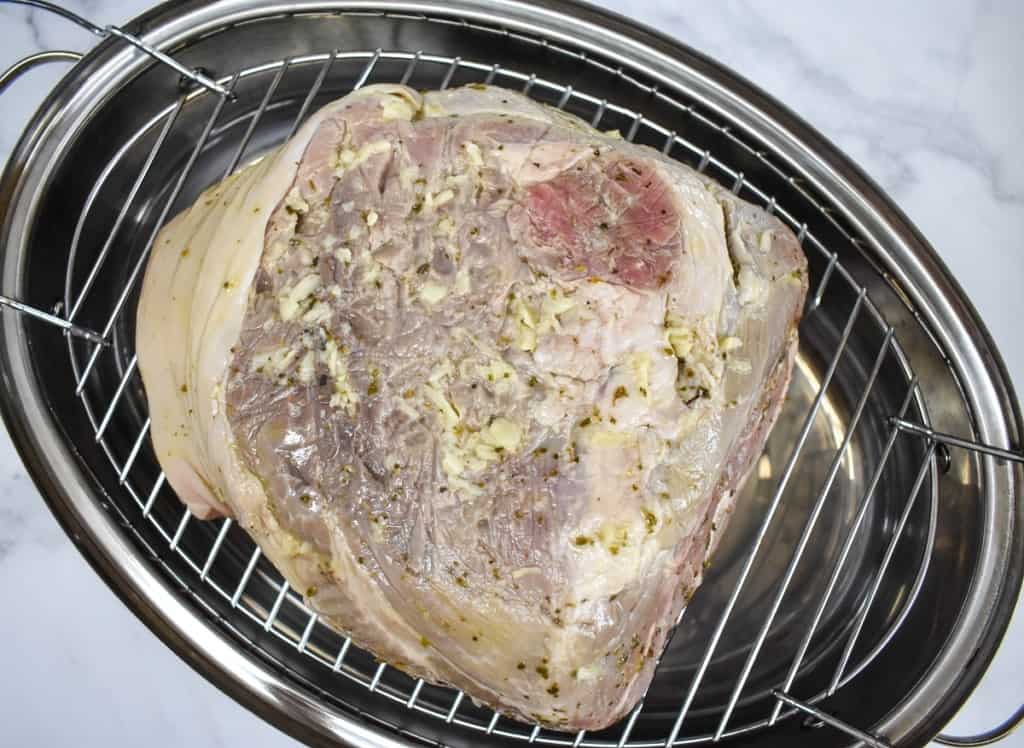
Brush any loose pieces of garlic off the pork. They will start to burn quickly. Also, pour just a little bit of water in the bottom of the roasting pan. You’ll have to add a little more during the roasting time too. The drippings and garlic on the bottom of the pan will start to burn and smoke. The water keeps this in check. Discard leftover marinade.
Roast the pork for a total of 6-7 hours until the internal temperature reaches at least 170° F and the meat has pulled away from the bone on one end. Check the temperature at several different spots. About 1½-2 hours into the roasting time tent the pork. Take a piece of aluminum foil (roughly the size of the pork shoulder) and loosely cover. Just place it on top, don’t wrap it.
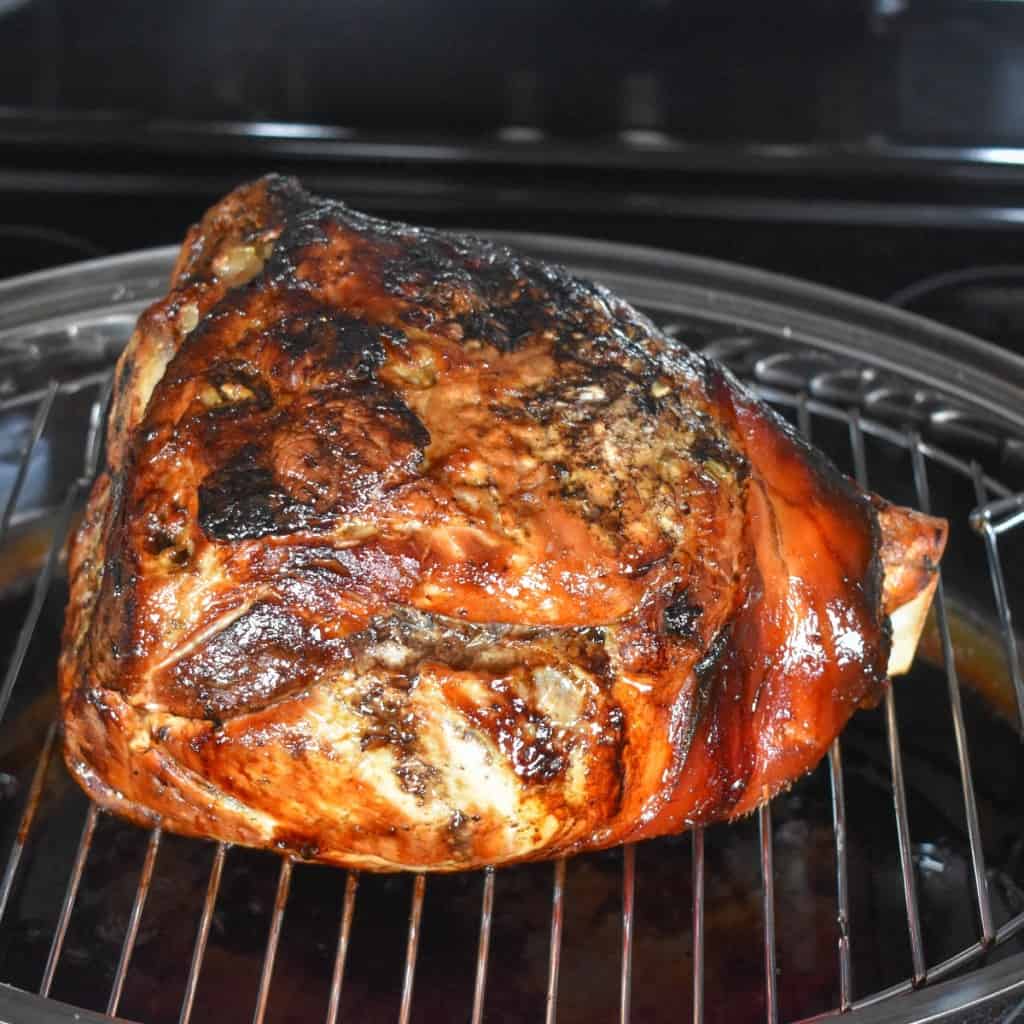
Crisp the skin
You can crisp the skin of the pork a little at the end, if desired. Remove the pork from the oven and carefully flip it over so it’s skin side up. Be very careful during this step because the roast is heavy and hot!
Fill a bowl or cup with water and add a generous amount of salt (about 1 tablespoon for 1 cup of water) stir. Drip a little of the salted water on the pork roast and brush it all over the skin. Repeat several times.
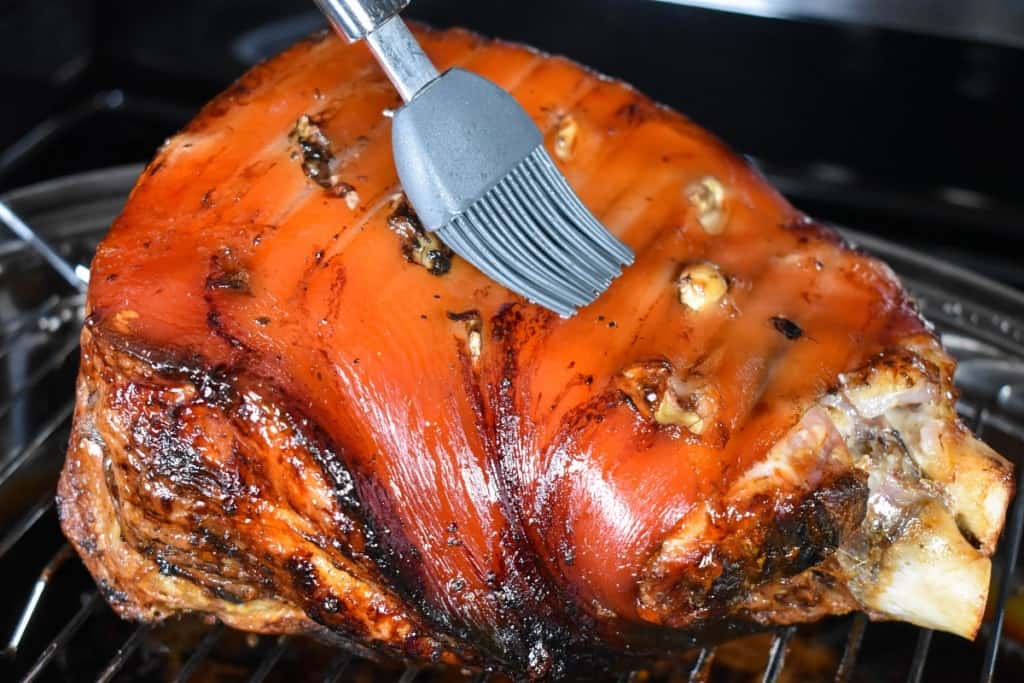
Make sure the pork isn’t sitting too close to the heat element. Move the rack down if you need to. Switch the oven to the low broiler setting.
Very Important Cook’s Note: Do not leave the oven’s side until you finish this step. Turn on the oven light and look in every minute or so. It will only take 2-4 minutes. The skin will crisp and brown quickly, it will go from perfectly golden brown to burnt in minutes, if not seconds.
Once the skin is bubbling and it may even start to crackle, carefully remove the pork from the oven, cover it loosely with a piece of foil and allow it to rest at least 20 minutes before carving.
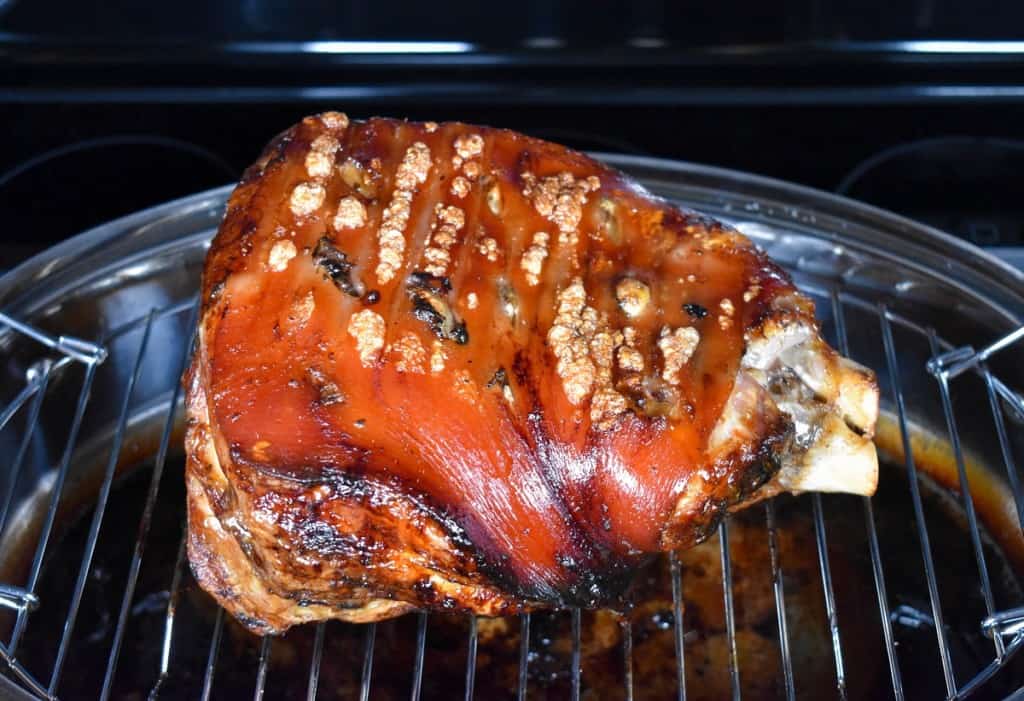
Side dish suggestions
Traditional side dishes served with lechon include the classic combination of white rice and black beans. For special occasions you’ll find yuca con mojo or fried yuca (yuca frita) served alongside the roasted pork. And of course, fried green plantains (tostones) or fried sweet plantains (maduros) are always a welcome side.
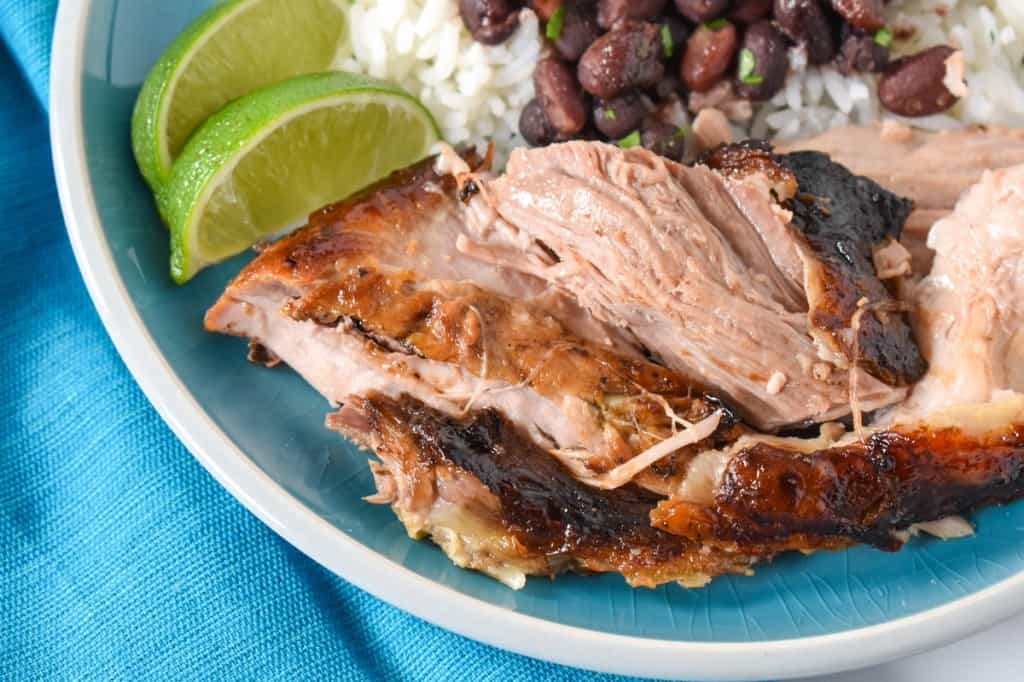
Storing and reheating
Refrigerate any leftover roast pork in an airtight container for 3-4 days. We take the pork off the bone so it’s easier to store.
You can also freeze the leftovers in an airtight container for up to 3-4 months.
The best way to reheat the lechon is in a skillet. Add a little bit of oil to a large skillet (we use non-stick) over medium heat. When the oil is hot, add the pork and cook for a few minutes turning occasionally until heated through.
You may also like:
- Ropa Vieja
- Arroz con Pollo
- Bistec de Palomilla
- Cuban-style Red Beans (frijoles colorados)
- Vaca Frita
📖 Recipe
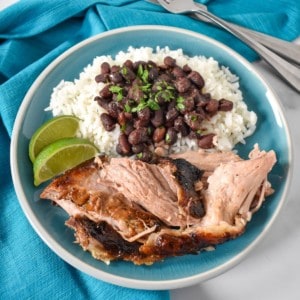
Cuban Roast Pork (Lechon Asado)
Ingredients
- 8-10 pound Pork Shoulder also called pork picnic (ours is 9¼ pounds)
- 2 Heads of Garlic peeled - divided (1 head for the mojo marinade and 1 head to insert in the pork)
- 1½ cups Sour Orange Juice how many oranges to use will depend on how large and juicy they are (about 3 pounds)
- 2 tablespoons Olive Oil
- 1 teaspoon Dried Oregano
- ¼ teaspoon Cumin
- 1 Bay Leaf
- 2 tablespoons Coarse Salt divided (1 teaspoon to break down the garlic, 1½ teaspoon for the mojo marinade, 1 teaspoon to sprinkle on the pork, about 1 tablespoon for the water to crisp the skin at the end)
Instructions
- You will also need: Mortar and pestle, a jar or container with a tight-fitting lid, meat mallet to smash the garlic (or use the side of a large knife), mesh strainer (to catch the seeds of the oranges), a large pan to marinate to pork, large marinating or roasting bag (optional) or plastic wrap to cover the pork while marinating, large roasting pan with a rack, aluminum foil to tent the pork, and cooking spray.
Make the mojo marinade
- Peel the 2 heads of garlic.
- Reserve 8-10 whole garlic cloves for the pork.
- Smash the remaining garlic cloves; place them on a cutting board and give them a good whack with a meat mallet or the side of a large knife.
- Add the smashed garlic and 1 teaspoon salt to a mortar and pestle. Work the garlic until you break it down into small flat pieces.
- Add the smashed garlic, sour orange juice, olive oil, oregano, cumin, 1½ teaspoon salt, and the bay leaf to a medium bowl or jar. Stir or shake to combine well.
- Cover the jar/bowl and let the marinade sit in the refrigerator for at least 1 hour, a couple of hours or overnight is better. Shake or stir well before using.
Marinate the pork
- Line a large pan with the roasting bag (if using). Place the pork in the pan.
- Make 8-10 (as many garlic cloves) small slits (about 1-2 inch deep) on the skin side of the pork.
- Insert the reserved whole garlic cloves into the slits. Dip the clove in the marinade to make inserting them easier.
- Turn the pork over (skin side down) and make about 10-12 small slits (about 1-2 inch deep) in the meat.
- Use a ladle or spoon and start pouring the marinade into the slits you made.
- Then, pour the remaining marinade over the pork. Sprinkle another 1 teaspoon of salt over the pork (if desired).
- Turn the pork, now it should be skin side up. We want the fleshy side sitting in the marinade.
- Seal the bag by making a tight knot on the top, or cover the pan well using a generous amount of plastic wrap.
- Marinate the pork in the refrigerator overnight.
Roast
- Remove the pork from the refrigerator 30 – 45 minutes before roasting (providing that it’s cool in your kitchen).
- Preheat the oven to 325°F
- The marinated pork will be a grayish color, that’s normal; it’s the citrus working on the meat.
- Lightly spray the rack of the roasting pan with cooking spray.
- Place the pork on the rack, skin side down.
- Brush any loose pieces of garlic off the pork. They will start to burn quickly.
- Pour a little bit of water in the bottom of the roasting pan. You’ll have to add a little more during the roasting time too. The drippings and any garlic pieces on the bottom of the pan will start to burn and smoke. The water keeps this in check. Discard leftover marinade.
- Roast the pork for a total of 6-7 hours until the internal temperature reaches at least 170° F and the meat has pulled away from the bone on one end. About 1½-2 hours into the roasting time tent the pork. Take a piece of aluminum foil (roughly the size of the pork shoulder) and loosely cover. Just place it on top, don’t wrap it.
Crisp the skin (if desired)
- Remove the pork from the oven and carefully flip it over so it’s skin side up. Be very careful during this step as the roast is heavy and hot!
- Fill a bowl or cup with water and add a generous amount of salt (about 1 tablespoon for 1 cup of water), stir. Drip a little bit of the salted water on the pork roast and brush it all over the skin. Repeat several times.
- Make sure the pork isn’t sitting too close to the heat element. Move the oven rack down if you need to. Switch the oven to the low broiler setting.
- Very Important Cook’s Note: Do not leave the oven’s side until you finish this step. Turn on the oven light and look in every minute or so. It will only take 2-4 minutes. The skin will crisp and brown quickly, it will go from perfectly golden brown to burnt in minutes, if not seconds.
- Once the skin is bubbling and it may even start to crackle, carefully remove the pork from the oven, cover it loosely with a piece of foil and allow it to rest at least 20 minutes before carving.
Video
Notes
Nutrition
The nutritional information above is computer generated and is only an estimate. There is no guarantee that it is accurate. This data is provided as a courtesy for informational purposes only.


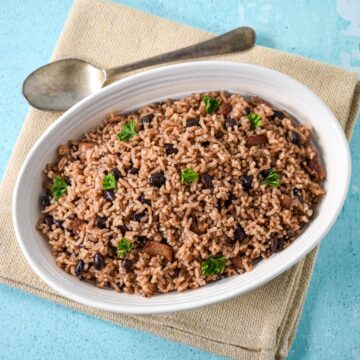

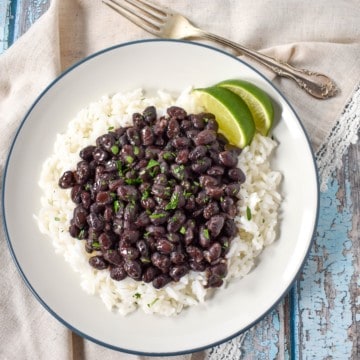

CLAIRE WOOD
This sounds wonderful.. I had this dish when we visited the Keys and loved it (we also fell in love with the Cubano sandwich) Question: Can this be made with a pork loin - the large kind, not the little tenderloins that weigh barely a pound) . I can get twin packs of them at Costco and freeze them. it would certainly be easier to marinade since I don't have anything which would hold a shoulder!!!
Elizabeth Rodriguez
If a whole shoulder’s too big, look for the boneless pork shoulder pieces (I’ve found them at Target)—they’re about 3–4 pounds, have a small fat cap, and fit well in a casserole dish. I’ve made it that way, and it turns out super tender.
Pork loin is very lean, so while the marinade adds flavor, it tends to come out dry with this cooking method. Shoulder is definitely the better option here.
If using a smaller cut, you can reduce the marinade or save half to use on something else—it's great on roast chicken too.
Stefano
Pork loin roast is far too lean, and lacks sufficient fat for this kind of preparation. Also, pork loin meat does not respond well to this “low and slow” method of roasting.
You can substitute a smaller pork picnic roast in place of the pork shoulder, and adjust your recipe quantities and roasting time accordingly.
Bill McGarry
Do you actually eat the ski, or trim it off?
Elizabeth
Hi Bill, Some people like the skin, especially when it gets crispy. I suggest you trim it off and get rid of the fat layer underneath. Then cut it into pieces with kitchen shears or chop it.
Audra
Can I cook this on a big green egg grill?
Elizabeth
Hi Audra,
I never have cooked this size/cut of meat on the grill and I've never used the green egg grill so I cannot comment on it. Perhaps search grilled pork shoulder or something along those lines. Thanks for stopping by.
Mimi
Hello..we don’t eat pork,,can we substitute you it with another meat. Thank you
Elizabeth
Hi Mimi,
You can use the mojo marinade on poultry (chicken, turkey, Cornish hens, etc.) but you will have to adjust the oven temperature and cooking time. Hope that helps, thanks for stopping by!
Giny
Hi there. I spent many years in Tampa and a friend there made this for big events and it was outstanding every time. VERY excited to try this! My one question is, We bought a beautiful pork shoulder roast that is boneless and weighs about 6.5 lbs. What adjustments do I need to make beyond watching the time/temp carefully? It does have the skin on one side. Thanks for your input!!
Elizabeth
Hi, Yes, watch the time. If the pork is split (where the bone was removed) and opens, I would recommend trussing it to create a uniform shape and so it cooks evenly. The marinating process and cooking set up should be the same. Good luck!
Kerry
This sounds amazing do you think the flavors would go well if I smoked the pork on my smoker instead of roasting in the oven?
Elizabeth Rodriguez
Hi Kerry, I've never had it smoked so I couldn't tell you.
Carol
Hi Elizabeth,
My question is about the orange Juice. Where cab I find sour OJ? If I can’t find it, will regular OJ work?
Thanks
Elizabeth
Hi Carol,
During the latter part of the year many Latin markets will stock sour oranges. If sour oranges are not available in your area you can make a pretty good substitute by combining orange juice (fresh squeezed is best) and lime juice at a 2:1 ratio. Two parts orange juice; one part lime juice. Shake or stir to combine well.
Another alternative is bottled sour orange juice. It’s not made with sour oranges; but even if it’s not the real thing, it will still get you that sweet and sour taste. Find it in the international section of large grocery stores, or online. Good luck!
Lizette
Thanks for the trick to crisp the skin, nada como un buen cuerito
Elizabeth
Absolutely!
Michele
Do you remove the garlic from the skin side?
Elizabeth
Hi Michele,
No, only brush off loose pieces of garlic.
Ade De Ruyter
Hi Elizabeth,
Your roast pork look so delicious. I’m planning to make it for new year.. I have a few questions for this recipe. Maybe sound like a stupid questions. But I will ask anyway 😄.
When you say Roast in the electric oven,What program do you use normally? Just conventional cooking ( top/ bottom heat ) ??? Or only the top?? And for the crispy skin also which heat do you used?
Thank you and hope you have wonderful and healthy holiday season..
Greetings from Belgium
Ade
Elizabeth
Hi Ade,
Thank you for your questions. I have an electric oven and the setting is bake. So I press “bake” and set the temperature to 325°F. It’s what you describe as conventional cooking (same as making a casserole or baking a cake). Make sure to lower the oven rack so that the pork is not sitting too close to the upper element.
For the skin we use the “broil” feature set to Low. This is only at the end and for a very short amount of time. The broil feature is direct heat and will burn the roast if left in too long. I hope this helps. Happy New Year!